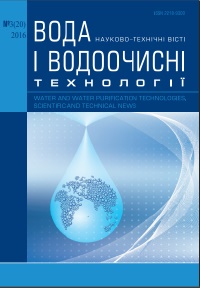WATER TREATMENT BIOTECHNOLOGY FOR BREEDING OF SHARPTOOTH CATFISH IN THE RAS
DOI:
https://doi.org/10.20535/2218-93002032016122682Keywords:
water treatment, nitrogen removal, RAS, biotechnologyAbstract
The aim of this work is to study the features of contaminated water formation in the recirculation aquaculture systems (RAS) plants for breeding of sharptooth catfish (Clarias gariepinus, Burchell 1820) and to develop the effective biotechnology for water quality recovering to allow water reuse. Disadvantages of classical water treatment technology from dissolved nitrogen compounds by using the nitrification with following denitrification lead to significant slowdown in the fish growth and increase the cost of products. On the basis of the analysis of pollutants concentrations in the catfish farm, which is working on the RAS-principle, the features of contaminated water formation and the reasons of low efficiency of facilities for mechanical and biological treatment were determined. The biotechnology that provides effective removal of dissolved nitrogen and phosphorus compounds by using phytoreactor with floating aquatic plants was proposed. Expediency of using molluscs in the processes of transformation of undissolved organic compounds in RAS water was proved. A comprehensive scheme of biological water treatment in RAS-plants for breeding of catfish was developed.
References
Bregnballe J. A Guide to Recirculation Aquaculture An introduction to the new environmentally friendly and highly productive closed fish farming systems /Jacob Bregnballe // FAO and EUROFISH. — 2015. — 97 р.
Bovendeur J. Design and performance of a recirculation system for high-density culture of the African catfish, Clarias gariepinus (Burchell 1822) / J. Bovendeur, E. Eding, A.M. Henken // Aquaculture. — 1987. — 63. — P. 329—353.
Schneider O. Analysis of nutrient flows in integrated intensive aquaculture systems / O. Schneider, V. Sereti, EH. Eding, JAJ. Verreth // Aquac Eng. — 2005. — 32. — р. 379—401.
Villaverde S. Nitrifying biofilm acclimation to free ammonia in submerged biofilters, Start-up influence / S. Villaverde, F. Fdz-Polanco, P.A. García // Water Res. — 2000. — 34. — Р. 602—610.
Rijn J. Aerobic and anaerobic biofiltration in an aquaculture unit-nitrite accumulation as a result of nitrification and denitrification / J.Rijn, G.Rivera // Aquacult. Eng. — 1990. — №9. — P. 217—234.
Tsukuda S. Heterotrophic denitrification of aquaculture effluent using fluidized sand biofilters / Scott Tsukuda, Laura Christianson, Alex Kolb, Keiko Saito, Steven Summerfelt // Aquacultural Engineering. — 2015. — Volume 64. — Р. 49—59.
Michaud L. Effect of particulate organic carbon on heterotrophic bacterial populations and nitrification efficiency in biological filters / L. Michaud, J.P. Blancheton, V. Bruni, R. Piedrahita // Aquac. Eng. — 2006. — 34. — Р. 224—233.
Rijn J. Denitrification in recirculating systems: Theory and applications / Jaap van Rijn, Yossi Tal, Harold J. Schreier // Aquacultural Engineering. — 2006. — 34. — Р. 364—376.
Lee, P.G. Denitrification in aquaculture systems: an example of fuzzy logic control problem / P.G. Lee, R.N. Lea, E. Dohmann, W. Prebilsky, P.E. Turk, H. Ying, J.L. Whitson // Aquacult. Eng. — 23. — 2000. — Р. 37—59.
Lochmann R. Multi-batch catfish production and economic analysis using alternative (low-cost) diets with corn gluten feed and traditional diets with meat and bone meal / Rebecca Lochmann, Carole Engle, Ganesh Kumar, Menghe H. Li, Jimmy L. Avery , Brian G. Bosworth , Craig S. Tucker // Aquaculture. — 2012. — 34. — P. 366—367.
Meriac A. Dietary carbohydrate composition can change waste production and biofilter load in recirculating aquaculture systems / Andre Meriac, Ep H. Eding, Johan Schrama, Andries Kamstra , Johan A. Jerreth // Aquaculture . — 2014. — 254. — P. 420—421.
Published
How to Cite
Issue
Section
License
Copyright (c) 2020 С. В. Кононцев

This work is licensed under a Creative Commons Attribution-NonCommercial 4.0 International License.
The ownership of copyright remains with the Authors.
Authors may use their own material in other publications provided that the Journal is acknowledged as the original place of publication and National Technical University of Ukraine “Igor Sikorsky Kyiv Polytechnic Institute” as the Publisher.
Authors are reminded that it is their responsibility to comply with copyright laws. It is essential to ensure that no part of the text or illustrations have appeared or are due to appear in other publications, without prior permission from the copyright holder.
WPT articles are published under Creative Commons licence:
- Authors retain copyright and grant the journal right of first publication with the work simultaneously licensed under CC BY-NC 4.0 that allows others to share the work with an acknowledgement of the work's authorship and initial publication in this journal. The use of the material for commercial purposes is not permitted.
- Authors are able to enter into separate, additional contractual arrangements for the non-exclusive distribution of the journal's published version of the work (e.g., post it to an institutional repository or publish it in a book), with an acknowledgement of its initial publication in this journal.
- Authors are permitted and encouraged to post their work online (e.g., in institutional repositories or on their website) prior to and during the submission process, as it can lead to productive exchanges, as well as earlier and greater citation of published work.

